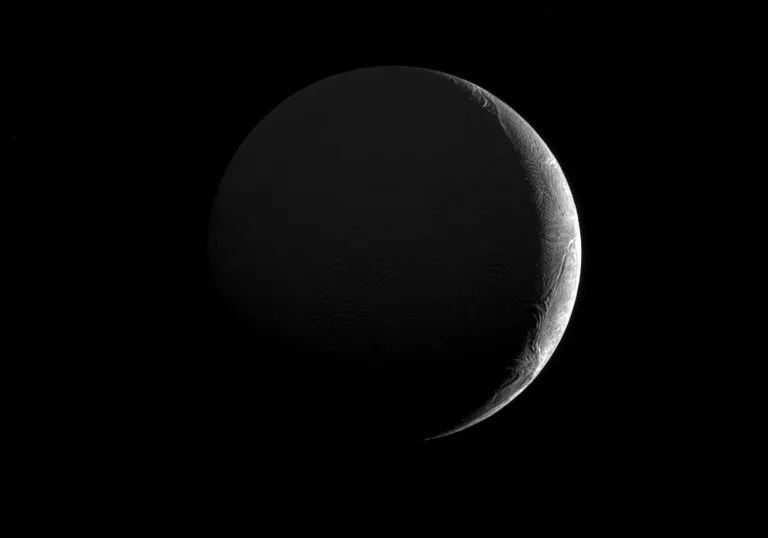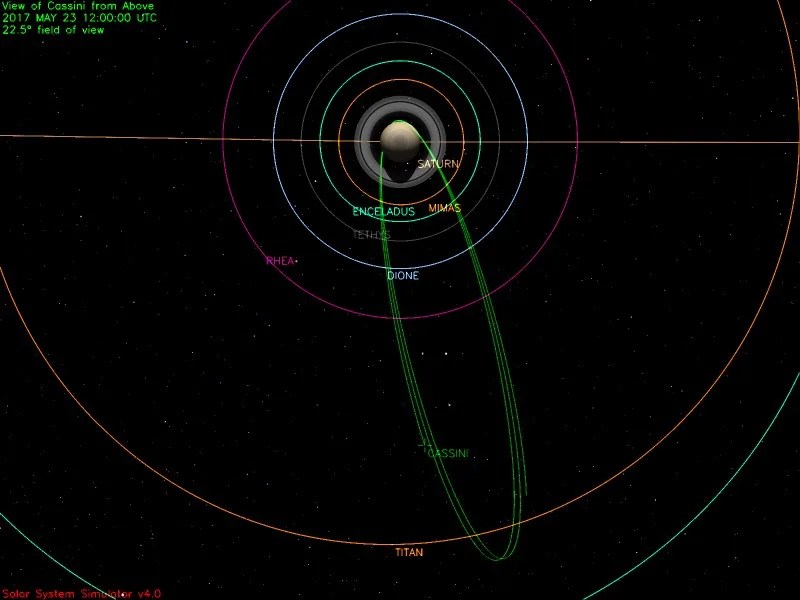6 min read

Cassini, and its counterpart the Deep Space Network, (DSN) are both quite complex systems. Normally they are also quite robust, and near-flawless performance is the norm. This week, though, two problems resulted in the loss of some important science data. On Friday, a heavy autumn rainstorm in Australia drowned out several hours of the digital downlink, the ones and zeroes of telemetry that carry images and other data from the spacecraft. Water naturally radiates radio waves near the same frequency as Cassini's distant signal, and the intense rainwater's radio-frequency noise was much "louder" than the very distant spacecraft; telemetry from several of Cassini's observations was lost for good. This is a calculated risk the mission takes and Cassini will often play back high-value data twice to assure successful delivery. A completely different ground-system problem occurred early on Monday morning during Cassini's periapsis passage, and it is described below.
Wednesday, May 17 (DOY 137)
Cassini's largest on-board telescope serves the Composite Infrared Spectrometer (CIRS). Today, the spacecraft was oriented to train CIRS on the ansa of Saturn's F ring for 14 hours, to look for variations in ring-particle properties while the rings' dust grains passed by. The observation was long enough to capture most of the ring's revolution about Saturn, which takes 14.8 hours. All the other telescopic, Optical Remote-Sensing (ORS), instruments participated: the Imaging Science Subsystem (ISS), the Ultraviolet Imaging Spectrograph (UVIS), and the Visible and Infrared Mapping Spectrometer (VIMS). Next, still watching the F-ring ansa, ISS began a 15-hour observation with the other ORS instruments riding along.
Thursday, May 18 (DOY 138)
Today, ISS turned and viewed Saturn’s sunlit northern crescent limb for 1.5 hours, working with VIMS and UVIS to study the composition of the planet's high atmosphere. The beautiful viewing geometry, which cannot be obtained from here on Earth, is illustrated here: https://go.nasa.gov/2rUImjG . When this observation was done, VIMS began a 10.5-hour global mapping of the planet, with CIRS and UVIS riding along. After starting this activity, Cassini coasted through apoapsis in its Saturn orbit, marking the start of Orbit #275.
Friday, May 19 (DOY 139)
VIMS observed an occultation of the bright star Sirius (Alpha Canis Majoris) by Saturn's atmosphere. UVIS rode along with this one-hour observation, which should provide better understanding of Saturn’s upper atmosphere.
CIRS turned back to Saturn and began an 11.1-hour mapping of the northern hemisphere, at mid-infrared wavelengths, with VIMS riding along. The objective was to determine upper troposphere and tropopause temperatures over multiple latitudes. This observation repeated on the following day for 12 hours, with UVIS joining VIMS as a rider.
Saturday, May 20 (DOY 140)
The flight team sent Cassini a file of 11,133 individual commands that make up the S100 sequence, using a DSN station in Australia today. S100 will begin exercising its control over the spacecraft on May 25, which it will continue through July 9. Then it will be time for the Cassini Mission's final command sequence, S101, to take effect.
Sunday, May 21 (DOY 141)
Speeding inbound over the planet today, VIMS led a five-hour observation with all the rest of the ORS instruments, creating a northern-hemisphere map of Saturn.
Next, Cassini turned and pointed its high-gain antenna dish towards Earth, and began receiving a stable uplink radio tone from the DSN, to use as a reference. Based on that reference, Cassini returned its continuous, frequency-stable downlink signals for two special Radio Science observations. For the next 24 hours, several ground-antenna stations belonging to the DSN and to the European Space Agency (ESA) would track Cassini, one after another as the Earth turned, in order to accomplish two objectives: (1) measure Saturn's gravitational field at close range and unprecedented detail, and (2) observe an occultation of Cassini's transmitters behind Saturn's rings. Over the course of a precious few repeated Radio Science opportunities such as today's, scientists should be able to measure mass distribution within Saturn, and deduce the mass of the rings.
Monday, May 22 (DOY 142)
Cassini plunged through Saturn's ring plane, interior to the rings, for the fifth time today, and passed periapsis a few minutes later. Unfortunately, a problem with the uplink signal disrupted some of the close gravity field measurement from being performed in its required closed-loop, "coherent" mode. There will be three more opportunities for these gravity field observations. On the other hand, the Radio Science ring occultation experiment was completed successfully.
The Cosmic Dust Analyzer (CDA) shared the prime spotlight during the ring plane crossing. While the Radio Science experiment required that Cassini’s High Gain Antenna point at the Earth, the spacecraft’s roll orientation was selected to provide the optimal attitude for CDA sampling of Saturn’s ring material.
This week's featured image was simple picture of a very complicated little moon of Saturn: /resources/17682 .
Tuesday, May 23 (DOY 143)
Today Saturn's largest moon Titan came within 118,000 kilometers of Cassini, and ISS, VIMS, Radar, and CIRS each took turns examining the planet-like moon over a period that would continue into the following day. CIRS managed to squeeze in a two-hour observation of Saturn's moon Dione earlier in the day, with the other ORS instruments participating.
The DSN communicated with and tracked Cassini on 15 occasions this week, using stations in California, Spain, and Australia; the European Space Agency supported twice using their stations in Australia and Argentina. A total of 11,145 individual commands were uplinked, and about 2,360 megabytes of science and engineering telemetry data were downlinked and captured at rates as high as 124,426 bits per second.
Wrap up:
Cassini is executing its set of 22 Grand Finale Proximal orbits, which have a period of 6.4 days, in a plane inclined 62.4 degrees from the planet's equatorial plane. Each orbit stretches out to an apoapsis altitude of about 1,272,000 km from Saturn, where the spacecraft's planet-relative speed is around 6,000 km/hr. At periapsis, the distance shrinks to about 2,500 km above Saturn's visible atmosphere (by comparison, Saturn is about 120,660 km in diameter), and the speed is around 123,000 km/hr.
The most recent spacecraft tracking and telemetry data were obtained on May 24 using the 70-meter diameter DSN station in California. The spacecraft continues to be in an excellent state of health with all of its subsystems operating normally except for the instrument issues described at http://saturn.jpl.nasa.gov/anomalies .
The countdown clock in Mission Control shows 115 days until the end of the Mission.
------------------------
This page offers all the details of the Mission's ending: <https://saturn.jpl.nasa.gov/mission/grand-finale/overview/>
------------------------
Milestones spanning the whole orbital tour are listed here:
<https://saturn.jpl.nasa.gov/mission/saturn-tour/tour-dates/>
------------------------
Information on the present position and speed of the Cassini spacecraft may be found on the "Present Position" page at:
<https://saturn.jpl.nasa.gov/mission/saturn-tour/where-is-cassini-now/>
------------------------
To unsubscribe from Cassini Spacecraft Updates or to subscribe with a different email address, visit:
<http://saturn.jpl.nasa.gov/news/mailinglistsignup/>
------------------------
For comments and questions, please contact Cassini Public Engagement at:
<http://saturn.jpl.nasa.gov/feedback/>
------------------------
This illustration shows Cassini's path up to mid-day May 23, when the spacecraft was climbing outbound from its most recent close encounter with Saturn.








